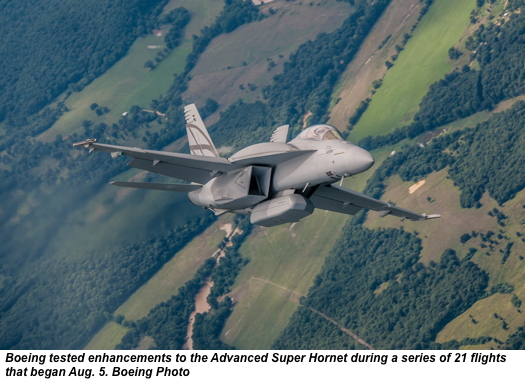Estimated reading time 5 minutes, 52 seconds.
Boeing reported that during three weeks of testing in August, it successfully demonstrated that its F/A-18 Advanced Super Hornet – fitted with new conformal fuel tanks (CFT) and an enclosed weapons pod (EWP) – will be able to outperform perceived threats well beyond 2030 in the anti-access, aerial denial environment. The advancement in capability is thanks to a suite of low-cost modifications, including enhanced stealth capabilities.
Although Canada has not yet disclosed what its requirements are to replace the CF-18 Hornet, Boeing believes that the Advanced Super Hornet should be considered a viable – and more importantly, affordable – option to replace the RCAF’s fleet of legacy fighters.
Speaking at Boeing’s St. Louis, Mo., facility where the company manufactures the F-15 Eagle and F/A-18 E and F Super Hornet, the company’s director of Super Hornet and Growler programs, Paul Summers, said that during the testing that took place in St. Louis as well as at the U.S. Naval Air Station Patuxent River, Md., the Advanced Super Hornet performed better than expected with its low-drag stealthy enhancements.
Earlier this year, Boeing announced that it would conduct flight tests with non-functioning upper wing mounted CFTs, and a non-functioning stealthy EWP, that were developed in conjunction with Northrop Grumman. These are both improvements that Boeing claims will not only help lower the fighter’s front radar cross section by up to 50 per cent, but will also increase its combat radius by up to 130 nautical miles, for a total combat radius of more than 730 nm, depending upon configuration.
Affixed to the centerline station, the EWP will allow the Advanced Super Hornet to carry either six small diameter bombs and two advanced medium-range air-to-air missiles (AMRAAMs); two 500-pound Paveways and two AMRAAMs; or an equivalent load up to 2,500 pounds (1,179 kg). The CFTs will carry 3,500 pounds of fuel. Summers explained during the briefing that the CFTs and EWP had negative or zero drag effect on the fighter, flown at subsonic speeds during testing.
The EWP and CFTs are just two of a suite of enhancements that could be made retrofittable to the Super Hornets that are now in service with the U.S. Navy and Royal Australian Air Force, or on the production line once the enhancements are made available. Other upgrades, which can be purchased separately or as a complete package, include the fitting of an integrated infrared search-and-track (IRST) system, an Elbit Systems large area display (LAD) “glass” cockpit and next-generation avionics, an internal missile and laser warning system, AESA (active electronically scanned array) radar upgrades, and new General Electric F-414-400 enhanced engines, that will provide up to 20 per cent more thrust while saving three per cent on fuel burn. However, all of these Advanced Super Hornet enhancements will not be available until 2020.
Priced at a fly-away cost of about $51 million (including both engines), the Super Hornet is priced lower than the $85 million (2020 dollars) Lockheed Martin F-35A. “The Block II Super Hornet is a great fit for Canada. It has many attributes that the RCAF is already accustomed to, especially in the types of environments that it operates its fighter aircraft in,” said ex-Canadian Air Force fighter pilot and Boeing chief pilot on the Super Hornet program, Ricardo Traven. “Canada could then upgrade its fleet of Super Hornets into the Advanced Super Hornet at a very affordable cost to Canadian taxpayers, as the upgrades become available in 2020.”
Boeing said that the cost to modify a Super Hornet to an Advanced Super Hornet is about an additional 10 per cent of the cost of the aircraft, or a little more than $5 million per fighter. “And a lot of additional capability comes with that,” said Traven. “The Super Hornet is flying today. It is a very well proven, reliable, twin-engine fighter that, I think, is ideally suited to meet Canada’s needs well into the future.”
But no one in the Royal Canadian Air Force has been fully briefed on the full potential of the Super Hornet. “To our knowledge, there has been no request made by Canadian officials for a top secret briefing on the full capabilities of the Super Hornet or Advanced Super Hornet,” said Mike Gibbons, VP of the Super Hornet and Growler programs. “Yes, we have provided briefings to RCAF personnel. But, we are limited in what we can disclose. So right now, only about 70 to 80 per cent of the fighter’s full potential is understood, until a top secret briefing is provided.”
Gibbons told Canadian Skies that the Super Hornet as we know it today is a very capable fighter aircraft “that will be able to remain dominant to threats well past 2030, with the enhancements that are being offered to make it the Advanced Super Hornet. It [the Advanced Super Hornet] can affordably meet Canada’s requirements, and at very low risk.”

